

R1X + R2CH |
|
|
|
|
|
|
PdL*n |
R1 |
* |
|
|
|
|
|
|
|
|
|
|
||||
|
C |
|
CH |
||||||||
|
|
|
R2 |
CH C |
|
C |
|||||
|
|
||||||||||
|
|
|
|
||||||||
|
|
|
|
|
|
|
|
|
|
|
|
|
|
|
|
|
|
|
|
|
|
|
|
IV.2.3 Asymmetric Heck Reactions
MASAKATSU SHIBASAKI and FUTOSHI MIYAZAKI
A. INTRODUCTION
The Pd-mediated coupling of aryl or vinyl iodides, bromides, or triflates with alkenes in the presence of a base, in other words, the Pd-catalyzed arylation or vinylation of alkenes, is generally referred to as the Heck reaction. It has been known to synthetic chemists since the late 1960s.[1]–[3] It is a great advantage that this reaction is not limited to activated alkenes. The substrate can be a simple olefin (with ethylene being the most reactive one), or it can contain a variety of functional groups, such as ester, ether, carboxyl, hydroxyl including phenolic ones, or cyano groups. Despite displaying many of the benefits usually associated with Pd-mediated reactions[4] (e.g., ease of scale-up and tolerance of water and/or other functional groups), interest in the reaction has been sporadic, largely due to problems of regiocontrol in the case of unsymmetrical alkene substrates and to an incomplete understanding of the reaction mechanism. In recent years, however, the attention paid to the reaction has increased dramatically,[5] and perhaps one of the most significant developments to date has been the advent of an enantioselective variant.[6],[7]
Given the many reports of chiral phosphine ligands dating from the early 1970s,[8] it is perhaps somewhat surprising that the phosphine-mediated Heck reaction was not subjected to dissymmetrization attempts until the late 1980s. However, it can be pointed out that the reaction has not usually been used to generate stereogenic centers,[9] and that for many years chelating diphosphines in general were thought to be unsuitable catalysts.[10] First reports of successful examples of the asymmetric Heck reaction (AHR) were received in 1989, and the reaction has since been successfully developed to the point where both tertiary and quaternary centers can be generated with ee values 80%. The bulk of the reported examples involves intramolecular reactions (i.e., ring closures),[11] which have the advantage of allowing relatively easy control of alkene regiochemistry and geometry in the product and of tolerating less reactive alkene substrates. In contrast, successful intermolecular reactions have until very recently been limited to quite reactive substrates, mainly O- and N-heterocycles, and to the formation of tertiary centers on ring carbon atoms, which again simplifies the question of alkene regiochemistry (but see Sect. F).
What follows is a survey of the relevant literature up to late 2000, including a discussion of the mechanistic aspects relevant for stereoselection in the AHR. The classification of the sections proceeds according to the various types of underlying carbon skeletons or natural product fragments of the resulting compounds. Diastereoselective variations,[5]
Handbook of Organopalladium Chemistry for Organic Synthesis, Edited by Ei-ichi Negishi ISBN 0-471-31506-0 © 2002 John Wiley & Sons, Inc.
1283
1284 |
IV PD-CATALYZED REACTIONS INVOLVING CARBOPALLADATION |
which have frequently been utilized for the construction of natual products, are generally not included.
B. REACTION CONDITIONS
The AHR is carried out under similar or identical reaction conditions generally associated with versions of the Heck reaction leading to racemic products using standard laboratory glassware. The solvents that have been used include benzene, dichloroethane, diglyme, dimethylacetamide, DMSO, THF, or even mixtures containing water. The reaction usually requires elevated temperatures (reflux, about 60–100 °C) to proceed at a reasonable rate. Generally, degassed solvents and an inert atmosphere (nitrogen or argon) are necessary to avoid decomposition of the Pd intermediates or oxidation of the phosphine ligand and the formation of other side products. Numerous bases have been applied, ranging from K2CO3 to proton sponge. The catalyst is conveniently generated in situ. Examples for palladium catalyst precursors are Pd(OAc)2 or Pd2(dba)3 CHCl3 (dba dibenzylideneacetone) among others, with usually at least about 3–10 mol % catalyst required for reasonable yields and reaction rates. The catalyst stability and the turnover numbers are relatively low compared to other catalytic processes and recovery of the catalyst is usually not practical. However, as AHRs can be employed for the construction of valuable natural products a somewhat higher catalyst cost is acceptable.
C. MECHANISTIC ASPECTS
The current state of mechanistic theory regarding the Heck reaction in general has been provided in recent review articles.[5],[12] In the following, the discussion will be a selective one, focusing primarily on the factors that influence the regioand enantiocontrol.[13],[14]
C.i. Factors Governing Regioselectivity
The mechanism of the Heck reaction (Scheme 1a) with bidentate phosphine ligands is generally thought to follow the four-step catalytic cycle shown in Scheme 1b, with the individual steps being: (i) oxidative addition of 1 to the Pd0 species 4, bearing a bidentate phosphine ligand, to give the PdII species 5; (ii) coordination and then syn-insertion of the alkene substrate 2 into the Pd—R1 bond of 5 to give 6; (iii) - or -hydride elimination from 6 to give either 3a or 3b; and finally; (iv) regeneration of 4 by reductive elimination of HX from 7.
The three major factors governing regioselectivity are:
1.The regioselectivity of the insertion into the Pd—R1 bond heavily depends on the nature of the steric and electronic environment provided by R2, R3, and R4 for unsymmetrically substituted alkenes. This lack of selectivity, which has tended to limit the scope of the reaction somewhat, can be overcome by selecting appropriate chiral ligands and reaction conditions.
2.The problem of competing - or -hydride elimination from 6 further complicates the regioselectivity issue, to the extent that the majority of reported Heck reactions simply avoid the problem by using simple acrylate substrates (R2 CO2R,
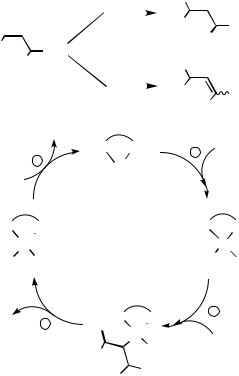
(a)
|
|
|
|
β |
|
α |
|
|
R1 |
|
X |
+ |
2 |
|
|
β′ |
3 |
|
|
|||||||
|
|
|
||||||
|
|
|
R |
|
|
|
R |
|
|
|
|
|
|
|
R4 |
|
|
1 |
|
|
2 |
|
|
|||
(b) |
reductive |
|
base HX |
|||||
|
|
|
||||||
|
|
elimination |
|
|
|
|||
|
|
|
|
|
|
|
D |
|
|
|
|
base |
|
||||
|
|
|
|
|
|
* |
|
|
|
|
|
|
P |
|
P |
|
|
|
|
|
|
|
|
PdII |
|
|
|
|
|
|
H |
|
X |
|
|
|
|
|
|
|
|
7 |
|
|
|
|
|
IV.2.3 |
ASYMMETRIC HECK REACTIONS |
1285 |
|||||
|
|
|
|
|
R2 |
|
|
β-hydride |
|
|
|
|
|
|
|
|
|
|
|
|
|
|
|
|
|
|
|
|
|
|
elimination |
|
|
|
|
|
|
R1 |
|
R3 |
|
||
|
|
|
|
|
|
product |
|
|||
|
|
|
|
|
3a |
R4 |
|
|
||
|
|
|
|
|
R1 |
|
|
β′-hydride |
|
|
|
|
|
|
* |
|
|
|
|||
|
|
|
|
|
|
elimination |
|
|||
|
|
|
|
|
R2 |
|
R3 |
|
||
|
|
|
|
|
|
|
||||
|
|
|
|
|
|
product |
|
|||
|
|
|
|
|
3b |
R4 |
|
|
||
|
|
|
* |
|
|
|
|
1 oxidative |
|
|
P |
P |
|
A |
|
|
|||||
|
|
addition |
|
|||||||
|
|
|
Pd0 |
|
|
|
|
|
||
|
|
|
|
|
|
|
|
|
|
|
|
|
|
4 |
|
|
|
|
|
|
|
|
|
|
|
|
|
|
* |
|
|
|
P P PdII
R1 X
5
3a or |
|
|
* |
B |
|
|
|
|
|
2 association |
|||
3b |
C |
R1 P |
P |
|||
and insertion |
||||||
|
|
|
PdII |
2 |
||
β- or β′-hydride |
β |
α |
into Pd—R1 |
|||
R2 |
X |
|
||||
elimination |
R4 β′ R3 |
|
||||
|
|
|
|
|||
|
|
|
6 |
|
|
|
Scheme 1
monosubstituted alkene), which through their highly unsymmetrical steric and electronic environment also avoid any problems with regioselectivity in step B. While this constitues a mild and quite powerful method for the synthesis of arylacrylates, by eliminating the possibility of -hydride elimination, an opportunity to form a tertiary chiral center is lost.
3.Even if the regioselectivity of step C can be controlled, a further problem lies in its reversibility, which can result in reinsertion of the alkene 3b into the Pd—H bond in 7 either to regenerate 6 or to form a regioisomer of it with the Pd atom attached to the same carbon atom as R3 and R4. If either of these substituents contains a suitably positioned hydrogen atom, then the possibility exists of a formal shift of the double bond in the alkene from the , - into a , -position, a problem that is especially prone to occur for endocyclic alkene products (see Sect. D.ii). Fortunately, methods have been developed to suppress this, involving the addition of thallium[15] or silver[16],[17] salts to the reaction mixture: the latter are usually preferred owing to their lower toxicity and fortuitous double role as enhancers of enantioselectivity (vide infra).
A preference for 3b rather than 3a formation is essential for the AHR to occur, and thus an examination of the factors controlling the competing elimination processes in step C
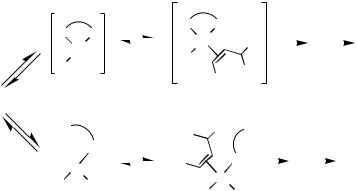
1286 |
IV PD-CATALYZED REACTIONS INVOLVING CARBOPALLADATION |
and the consequent prerequisites for ensuring the predominance of the desired pathway is clearly apropos. As both the insertion into 5 and the elimination from 6 are syn-processes, rotation around the alkene -bond is required before -hydride elimination can occur. This might be expected to make -hydride elimination the kinetically more favorable pathway. More significantly, for endocyclic alkenes, the necessary -bond rotation is not feasible for steric reasons, making -hydride elimination the only possible course. It is primarily for this reason that all the AHRs forming tertiary centers, which have been reported (with the exception of the allylsilane reactions by Tietze and colleagues—see Sect. D.i.e), involve endocyclic alkene substrates. Other methods to direct the selectivity of step C involve choosing suitable Rn groups to influence the relative thermodynamic stabilities of the possible products, the most common tactic being to make R3/R4 OH or OR, resulting in the formation of an enol (which subsequently tautomerizes to the aldehyde or ketone) or enol ether. A similar strategy commonly employed in AHRs is to choose R3/R4 alkenyl, resulting in the formation of a conjugated diene product. Either approach may be used in addition to the choice of a cyclic substrate as a way of providing an extra driving force to the reaction, and this indeed occurs in many of the published AHR examples.
C.ii. Factors Governing Enantioselectivity
The key step in the catalytic cycle with regard to enantioselectivity is clearly B, association of the alkene 2 and insertion of it into the Pd—R1 bond. As with the Heck reaction itself, the mechanism for this process remains a matter for conjecture, with the overall rationale currently in favor having been proposed in 1991 by Ozawa, Kubo, and Hayashi,[18] and independently by Cabri et al.[19] (although the cationic pathway via 8 and 9 had been proposed as early as 1990 [20] ). Its development and subsequent evolution have recently been reviewed by Cabri and Candiani.[12]
Two possible routes are proposed (Scheme 2a), the former (“cationic”) pathway beginning with the dissociation of X from 5 to generate the tricoordinate 14e cationic complex 8 with the accompanying counterion X . Complexation of 2 into the vacant site then gives the 16e species 9, and insertion of 2 into the Pd—R1 bond followed by reformation of the Pd—X bond gives 6 as desired, with the chiral bidentate ligand having
(a) |
,, |
|
,,cationic |
|
pathway |
|
5 |
|
,, |
|
neutral,, |
|
pathway |
|
|
|
|
|
* |
|
|
|
|
|
|
|
|
|
|
|
||
|
* |
|
|
|
|
|
P + |
P |
|
|
|
|
|
|
|
|
|
|
P |
+ P |
|
|
|
|
|
|
|
|
|
|
|
|
|
|
|||
|
|
|
|
PdII |
|
R4 |
|
|
|
6 |
|
|
3b |
|||||
|
|
|
|
|
|
|
|
|
|
|||||||||
|
|
|
|
|
|
|
|
|
|
|||||||||
|
|
|
|
|
|
|
|
|||||||||||
R1 |
PdII |
X− |
|
|
R1 |
|
|
3 |
X− |
|
high ee |
|||||||
|
|
|
|
|
R2 |
R |
|
|
||||||||||
|
|
|
|
|
|
|
|
|
|
|
|
|
|
|
|
|
||
|
8 |
|
|
|
9 |
|
|
|
|
|
|
|
|
|
|
|||
|
|
|
|
|
|
|
|
|
|
|
|
|
|
|
||||
P |
* |
|
|
|
|
R3 |
R4 P |
|
|
|
|
|
|
|
|
|
||
|
|
P |
|
|
|
|
* |
|
|
|
|
|
|
|
|
|
|
|
|
|
|
|
|
|
|
|
P |
|
|
6 |
|
|
|
3b |
|||
|
Pd |
II |
|
|
|
|
R2 |
|
|
|
|
|
|
|||||
|
|
|
|
|
|
|
|
|
|
|||||||||
|
|
|
|
|
|
|
||||||||||||
|
|
|
|
|
|
|
PdII |
|
|
|
|
|
|
|
low ee |
|||
R1 |
|
X |
|
|
|
|
R1 |
|
|
|
|
|
|
|
||||
|
10 |
|
|
|
|
|
11 |
X |
|
|
|
|
|
|
|
|
|
|
|
|
|
|
|
|
|
|
|
|
|
|
|
|
|
|
|
||
Scheme 2a
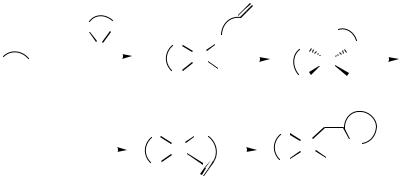
|
|
|
|
|
|
|
|
IV.2.3 |
ASYMMETRIC HECK REACTIONS |
1287 |
||||||||||||
(b) |
* |
|
|
|
|
|
|
|
|
|
|
|
|
|
|
|
|
|
|
|||
|
|
|
|
|
|
|
|
|
|
|
|
|
|
|
|
|
|
|
|
|
|
|
|
|
|
P |
|
P |
P |
Ar |
|
P |
|
|
|
|
|
|
|
||||||
|
|
|
|
Pd |
|
|
|
Ar |
|
|
|
|||||||||||
XAr |
|
|
|
|
|
|
|
Pd |
|
|
|
|
|
|
|
Pd |
|
|
|
|||
|
|
|
* |
|
|
|
|
|
* |
|
|
|
||||||||||
|
|
|
X |
|
|
|
||||||||||||||||
|
|
|
|
|
|
|
|
P |
|
|
|
|
|
|
|
|||||||
|
|
|
|
|
|
|
|
|
P |
|
|
X |
|
|
|
|||||||
|
|
|
|
|
|
|
|
|
|
|
|
|
|
|
|
|
|
|
|
|||
|
|
|
|
|
|
|
|
|
|
|
|
|
|
|
|
|
|
|
|
|
|
|
|
|
|
|
|
|
|
P |
+ Ar |
|
|
|
|
|
P |
|
|
Ar |
|
||||
|
|
|
|
|
|
* |
Pd |
|
|
* |
|
Pd |
|
|
|
|||||||
|
|
|
|
|
|
|
|
|
|
|||||||||||||
|
|
|
|
|
|
|
P |
|
|
|
|
|
|
P |
X |
|
||||||
X−
Scheme 2b
remained fully chelated throughout and so having maximized the asymmetric induction. The alternative (“neutral”) pathway starts with dissociation of one arm of the bidentate ligand resulting in the neutral species 10; association and complexation into the vacant site of 2 gives the neutral species 11, which by alkene insertion into Pd—R1 and recomplexation of the previously displaced phosphine moiety also gives 6.
The nature of X in 1 (and thus the strength of the Pd—X bond in 5) is clearly an important factor; unless the reaction conditions are modified, aryl and alkenyl triflates are generally assumed to follow the cationic pathway (the Pd—OTf bond being weak [21] ) with either route being available to reactions using aryl/alkenyl halides. In practice, it has proved possible to influence which pathway will be followed in a given Heck process, either by adding silver salts to the reaction of an aryl/alkenyl halide (the halophilic Ag salt sequestering the halide from 5 and replacing it with its own anionic component [6] ), or by adding excesses of halide anions to reactions using triflates (resulting in nucleophilic displacement of the triflate anion from 5[22] ). The nature of the alkene substrate is also important, with electronrich alkenes favoring the “cationic” pathway (and so being the most suitable for the AHR) while the “neutral” pathway makes for faster reaction with electron-poor substrates.[19]
The partial dissociation of the chiral ligand during the “neutral” process would seem to make it less well suited to asymmetric induction, however, and the evidence of most of the AHRs reported so far seems to indicate that conditions which favor the “cationic” route also give the best enantiomeric excesses (ees). However, a significant exception to this rule has been found (see also Sect. E.i). Overman, Poon, and co-workers observed that for a special aryl triflate [(Z )-butenanilide triflate] the addition of halide salts to the reaction mixture resulted in a dramatic increase in ee of the intramolecular Heck reaction product.[23],[24] If, on the other hand, the corresponding aryl iodide was used as starting material, high ees could be obtained without further additives. Overman concluded that in the case of this substrate the “neutral” pathway must be the more enantioselective one. Furthermore, it was shown that, when the bidentate diphosphine ligand (R)-BINAP was substituted by potentially monodentate analog of (R)-BINAP, only low enantioselectivities were obtained for this example. This can be taken as evidence that both phosphines of the diphosphine ligand remain coordinated to the Pd center during the enantioselective step. It was also shown that enantioselectivity in this neutral pathway was unchanged in going from dry DMA to DMA containing 5% water.[24] To account for these findings mechanistically, a “refined” neutral pathway for the AHR involving a pentacoordinate intermediate without partial dissociation of the diphosphine was suggested (Scheme 2b).

1288 |
IV PD-CATALYZED REACTIONS INVOLVING CARBOPALLADATION |
It is clear that considerations on the geometry of the palladium center during the catalytic cycle are fundamental for further developments of more detailed descriptions of the stereoinduction. Explicit three-dimensional rationalizations on how the chirality is transferred from the ligand to the substrate are not available for the AHR at present or are just beginning to emerge (see Sect. D.i.d).
D. FORMATION OF TERTIARY CARBON CENTERS
D.i. Intramolecular
D.i.a. Decalins. The first example of an asymmetric Heck reaction was reported in 1989 and involved the conversion of the prochiral alkenyl iodides 12a–c into the chiral decalin systems 13a–c, as shown in Scheme 3.[25] The reaction conditions (dipolar aprotic solvent and presence of silver salts), while similar to those of a previously reported nonenantioselective method,[16] differ crucially in respect of the choice of the chiral ligand and of solvent—very low or negligible ees were obtained using THF, MeCN, or DMSO, with the preferred solvent being N-methyl-2-pyrrolidinone (NMP). Similarly, the widely used chiral phosphine ligands 1-t-butoxycarbonyl-4-diphenylphosphino-2- (diphenylphosphinomethyl)azolidine (BPPM) and N,N-dimethyl-1-[1 ,2-bis (diphenylphosphino)ferrocenyl]ethylamine (BPPFA) failed to give significant asymmetric inductions, with (R)-BINAP proving to be the ligand of choice, a pattern that has been repeated in most (though not all—see Sect. D.i.c) of the reported examples of the AHR. By using a prochiral substrate, two stereocenters can be set in one step, a tactic that is used repeatedly in the tertiary center-generating AHRs reported by the Shibasaki group.
R
|
|
Pd(OAc)2 (3 mol %) |
|
|
|
(R)-BINAP (9 mol %), NMP |
|
I |
12 |
Ag2CO3 (2.0 equiv), 60 °C |
|
|
|
||
R |
|
|
|
|
|
Pd(OAc)2 (5 mol %) |
|
|
|
(R)-BINAP (10 mol %), PhMe |
|
OTf |
|
K2CO3 (2.0 equiv), 60 °C |
|
14 |
|
|
|
R |
(a) 74% (46% ee) |
|
|
|
(b) 70% (44% ee) |
|
(c) 66% (36% ee) |
H 13 |
|
R |
(a) 54% (91% ee) |
|
|
|
(b) 35% (92% ee) |
|
(c) 44% (89% ee) |
H |
(d) 60% (91% ee) |
13 |
|
(a) R = CO2Me, (b) R = CH2OTBS, (c) R = CH2OAc, (d) R = CH2OPiv
Scheme 3
The modest ees reported (33– 46%) for the conversion from 12 to 13 were greatly improved as a result of a study of the effects on the reaction of varying the anionic component of both the Pd source and more particularly the silver salt.[20] It was found that the use of a Pd0 catalyst complex preformed in situ from Cl2Pd(R)-BINAP,[26] (R)-BINAP, and cyclohexene gave greatly improved ees relative to the 1:3 Pd(OAc)2/(R)-BINAP prereduced catalyst used in the original work; in contrast, the use of AgOAc as the Ag source reduced the ee to almost zero, clearly indicating the undesirability of the nucleophilic

IV.2.3 ASYMMETRIC HECK REACTIONS |
1289 |
acetate counterion, which perhaps forms a Pd—OAc bond to replace the easily dissociated Pd—I bond, and so inhibits the cationic pathway. The best Ag source in terms of ee was found to be Ag3PO4 (most likely due to the very low nucleophilicity of the Ag2PO4 anion), with the sparingly soluble CaCO3 being added as the basic component. Under these conditions, 13b was obtained with 80% ee and in 67% yield.
The very recent introduction of the new ligand 2,2 -bis(diphenylarsino)-1,1 -binaph- thyl (BINAs),[27] the diarsine equivalent of BINAP, helped to considerably increase the yield for the conversion of 12b to 13b (Scheme 3). After optimization, the product 13b could be prepared in 90% chemical yield and with 82% ee.[27]
The use of the alkenyl triflates 14a–d in place of iodides 12a–c gave still better results[28] as well as allowing the omission of expensive silver salts and the use of hydrocarbon solvents (PhMe or PhH), in which the deleterious effects of Pd(OAc)2 on ee seen in NMP are not repeated. Thus, products 13a–d were obtained in 35–60% yields and with uniformly excellent (89–92%) ees under the conditions indicated.
The scope of the reaction was extended somewhat by the use of the trisubstituted alkenyl iodide 15, which gave the decalin systems 16a and 16b in yields of 63% (83% ee) and 67% (87% ee), respectively (Scheme 4).[28] The deleterious effect of the acetate counterion on ee and favorable influence of the Ag3PO4/CaCO3 additive combination seen for the AHR conversion of 12 to 13 are reproduced here. Interestingly, 16a was accompanied by a minor amount (35%) of the desilylated alcohol 16c, which displayed a higher ee (92%)—control experiments indicated that desilylation was occurring via transmetallation to Pd after completion of the ring closure. No such free hydroxyl formation was seen in the case of the acetate 15b.
OTBS |
|
|
OTBS |
|
Cl2Pd[(R)-BINAP] (10 mol %) |
(a) 63% (83% ee), |
|
|
|
|
plus (c) 35% (92% ee) |
|
Ag3PO4 (2 equiv), NMP, 60 °C |
||
|
|
||
I 15a,b |
CaCO3 (2.2 equiv) |
H 16a−c |
|
|
|
RO |
(b) 67% (87% ee) |
OR
(a) R = TBS, (b) R = Ac, (c) R = H
Scheme 4
A more significant extension in scope was the synthesis of a range of bicyclic enones and dienones, including a key intermediate 20 in Danishefsky’s synthesis[29] of vernolepin 21. The AHR involved was initially the conversion of the bisallylicalcohol 17 to the chiral decalin system 19, via the intermediate 18 (Scheme 5).[30] The best solvent for this was found to be 1,2-dichloroethane (DCE), with the addition of t-BuOH having a beneficial effect on the reaction rate and the chemical yield without reducing the ee.[31] Compound 19 was converted to 20 via a nine-step process; an alternative approach was also found, which started from the more readily available 13a.[32] Application of the DCE/tertiary alcohol solvent system for the conversion of 14a to 13a gave an improved yield relative to that previously reported; a study of the various tertiary alcohols found pinacol to be the most efficacious, giving 13a in 78% yield with 95% ee. The authors successfully synthesized ( )-21, thereby making an assignment of its absolute configuration possible.
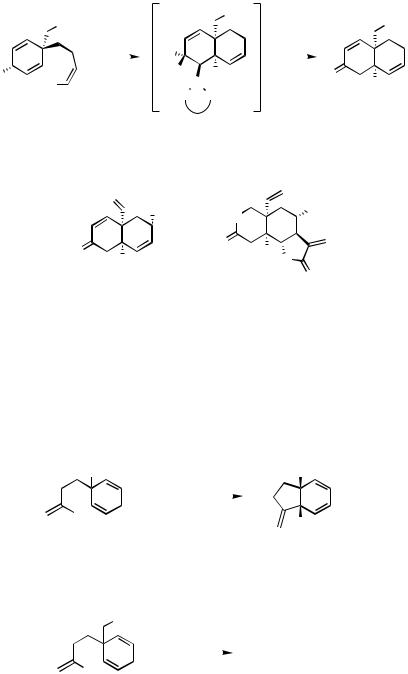
1290 |
IV |
PD-CATALYZED REACTIONS INVOLVING CARBOPALLADATION |
|||||||
|
|
OPiv |
|
|
|
OPiv |
|
OPiv |
|
|
|
|
|
|
|
|
|||
|
|
|
(a) |
HO |
|
|
|
(b) |
|
|
|
|
|
|
|
|
|
|
|
|
HO |
TfO |
H |
Pd + |
H |
|
|
O |
|
|
|
P |
|
|
|
H |
|||
|
|
17 |
|
P |
18 |
19 |
|||
|
|
|
|
* |
|
||||
(a) Pd2dba3.CHCl3 (9 mol % Pd), (R)-BINAP (11.3 mol %), K2CO3 (2 equiv), t-BuOH (11 equiv), ClCH2CH2Cl, 60 °C, 3 d. (b) β-hydride elimination, then tautomerization, 76%, 86% ee.
|
O |
|
|
|
|
OH |
||
|
|
|
O |
|
|
|
|
|
|
|
|
|
|
|
|
||
|
|
|
|
O |
||||
O |
H |
O |
|
|
|
H O |
||
|
|
|||||||
|
|
|
|
|||||
|
|
|
|
|
||||
|
|
|
|
|
|
|
|
O |
|
20 |
|
21 |
|||||
|
|
|
|
Scheme 5 |
||||
D.i.b. Hydrindans. The general method described in Sect. D.i.a for decalin synthesis has also been applied to the synthesis of 6,5-ring systems through the formation of hydrindans (Scheme 6).[33]
Both the iodides 22a–e and the triflate 24 could be converted to the corresponding cis- hydrindans by similar methods to those used for decalins; once again Ag3PO4 was found to be the most effective silver salt in the conversion of the former. Small increases ( 5%)
R |
|
|
R |
|
|
|
(a) |
||
|
|
|
|
|
I |
|
|
H |
|
|
|
|
|
|
22a: R = CO2Me |
|
|
23a: 73%, 83% ee |
|
22b: R = CH2OTBS |
|
|
23b: 78%, 82% ee |
|
22c: R = CH2OAc |
|
|
23c: 73%, 84% ee |
|
22d: R = CH2OTBDPS |
|
|
23d: 53%, 73% ee |
|
22e: R = CH2OPv |
|
|
23e: 74%, 80% ee |
|
OTBS |
|
|
|
|
|
|
(b) |
||
OTf |
|
|
23b |
|
|
||||
|
|
|
||
24
(a)PdCl2[(R)-BINAP] (10 mol %), Ag3PO4 (2.0 equiv), CaCO3 (2.2 equiv), NMP, 60 °C.
(b)Pd(OAc)2 (5 mol %), (R)-BINAP (10 mol %), K2CO3 (2.0 equiv), benzene, 60 °C, 64 h, 63% (73% ee).
Scheme 6

IV.2.3 ASYMMETRIC HECK REACTIONS |
1291 |
in ee could be obtained for 22a–c by prereducing the palladium catalyst in situ. The triflate 24 gave 23b with slightly lower ee than seen for the corresponding conversion of 22b, with potassium carbonate being the most effective base.
The hydrindan 23b was later converted by the same group into 26 (Scheme 7),[34] which is a key intermediate in the synthesis of ( )-oppositol and ( )-prepinnaterpene.[35] The conversion involved oxidation of the diene moiety with singlet oxygen and is notable for the clean epimerization of the ring junction to give the trans-configuration (from 25 to 26), which demonstrates that both cis- and trans-junctions can be obtained in the AHR products.
|
Br |
|
|
Br |
23b |
|
|
|
|
BnO |
H |
BnO |
H |
OH |
O |
|
|||
|
25 |
|
26 |
|
|
Scheme 7 |
|
|
|
D.i.c. Indolizidines. The 6,5-combination bicycle synthesis outlined above has been extended to indolizidines, formed by AHR of a suitable prochiral alkenyl iodide such as 28, which can easily be prepared by allylation of the lactam 27. In contrast to purely carbocyclic systems, however, the most effective ligand proves to be (R)- -[(S)-1 ,2- bis(diphenylphosphino)ferrocenyl]ethyl alcohol (BPPFOH) 31,[36] which gives results clearly superior to those obtained with BINAP (Scheme 8).[37],[38]
|
|
|
|
|
|
|
|
|
|
|
|
|
|
H |
|
|
|
|
H |
|
|
|
|
|
|
|
|
I |
|
|
|
|
|
||||||||
|
|
NH |
(a) |
|
|
|
(b) |
|
|
N |
+ |
|
|
|
N |
|||||
|
|
|
|
|
|
|
|
|
||||||||||||
|
|
|
|
|
N |
|
|
|
|
|
|
|
|
|
|
|||||
|
|
|
|
|
|
|
|
|
|
|
|
|
|
|
||||||
|
|
|
|
|
|
|
|
|
|
|
|
|
|
|
|
|||||
|
|
|
|
|
|
|
|
|
|
|
|
|
|
|
|
|
|
|
|
|
O |
|
O |
|
|
|
|
|
O |
(c) |
O |
||||||||||
27 |
28 |
|
|
|
|
|
|
|
|
|
|
|
|
|
||||||
|
|
|
|
|
|
|
|
|
|
|
|
|
|
|||||||
30 |
|
29 |
||||||||||||||||||
|
|
|
|
|
|
|
|
|||||||||||||
(a) NaH, DMF, then (Z)-CHI=CH |
|
CH2I, 68%. (b) Pd2dba3.CHCl3 (4 mol % Pd), |
||||||||||||||||||
|
||||||||||||||||||||
(R)-(S)-BPPFOH (9.6 mol %), Ag-exchanged zeolite (corresponds to ca. 6 equiv Ag), CaCO3, DMSO-DMF, 0 °C, 94% (86% ee). (c) Pd/C, MeOH, 23 °C, quantitative.
|
|
|
OH |
H |
|
OH |
H |
|
|
|
|
|
||
|
|
|
|
|
Fe |
PPh2 |
N |
OH |
N |
|
PPh2 |
|
C6H13 |
|
|
|
|
||
|
31 |
32 |
|
33 |
|
|
Scheme 8 |
|
|
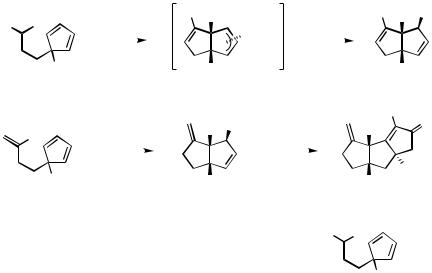
1292 |
IV PD-CATALYZED REACTIONS INVOLVING CARBOPALLADATION |
The use of an Ag-exchanged zeolite also appears to give somewhat better results than the more usual Ag3PO4 silver source. The desired indolizidine 30 is obtained as a mixture (94% yield, 86% ee) with the isomer 29; however, treatment of the mixture with catalytic Pd/C in MeOH at room temperature gives clean isomerization to 30 in essentially quantitative yield. Compound 30 has been converted to the natural products lentiginosine 32, 1,2-diepilentiginosine, and gephyrotoxyn 209D 33.[39]
D.i.d. Diquinanes. The successful execution of AHRs for the formation of 6,6- and 6,5- ring systems from prochiral substrates clearly suggested an extension of the method to the formation of 5,5-systems, which form the backbone of a large number of natural products. The use of prochiral cyclopentadienyl systems, however, involves the generation of a -allylpalladium species, which must then be trapped with a suitable nucleophile.[40] The greater reactivity of the 1,3-diene substrate toward the silver salts used in the reactions and the propensity for undesirable side reactions such as Diels–Alder cycloadditions must also be borne in mind. The former problem, in fact, figures prominently in the first example of an AHR-based diquinane synthesis to be published (Scheme 9).[41],[42]
Me |
|
I |
|
|
Me |
H |
|
|
|
|
|
Me |
H |
OAc |
|
|
|
|
|
|
|
|
|
|
|
|
|||||
|
(a) |
|
|
Pd+Ln* |
|
|
|
||||||||
|
|
Me |
|
Me |
|
Me |
|
||||||||
|
|
|
|
|
|||||||||||
|
|
|
|
|
|
|
|
|
|
|
|
||||
|
|
|
|
|
|
|
|
|
|
|
|
||||
|
34 |
|
|
|
|
|
|
|
|
|
|
|
35 |
|
|
|
|
|
|
|
|
|
|
OAc |
EtO2C |
|
O |
||||
|
|
OTf |
|
|
|
H |
H |
|
|||||||
|
|
(b) |
|
|
7 steps |
|
|
||||||||
|
|
|
|
|
|
|
|
||||||||
|
|
|
|
|
|
|
|
|
|
|
|
|
|
H |
|
|
|
Me |
|
|
|
Me |
|
|
|
|
|
Me |
|
||
|
|
|
|
|
|
|
|
|
|
|
|
||||
|
36 |
|
|
|
|
37 |
|
|
|
|
|
38 |
|
|
|
|
(a) [Pd(allyl)Cl]2, (R,R)-CHIRAPHOS, Bu4NOAc, PhMe, Me |
OTf |
|
|
|||||||||||
|
60 °C, 6 d, 61% (20% ee). |
|
|
|
|
|
|
|
|
|
|
||||
|
|
|
|
|
|
|
|
|
|
|
|||||
|
(b) Pd(OAc)2, (S)-BINAP, Bu 4NOAc, DMSO, 25 °C, 2.5 h, |
|
|
|
|||||||||||
|
|
|
|
||||||||||||
|
89% (80% ee). |
|
|
|
|
|
|
|
|
|
Me |
|
|
||
|
|
|
|
|
|
|
|
|
|
|
|
|
39 |
|
|
|
|
|
|
|
|
|
Scheme 9 |
|
|
|
|||||
Although cyclization of the iodide 34 could be carried out to give the bicyclo[3.3.0]- octane 35 in reasonable yield, the observed ees were low [ca. 20%; a slightly higher ee was obtained with (S)-BINAP, but at the cost of greatly reduced yield]. The authors attribute this failure in large part to a clearly observed instability of 34 in the presence of silver salts, necessitating their omission from the reaction medium and so forfeiting the beneficial effects noted in earlier work.[20] The presence of tetrabutylammonium acetate, a source of nucleophilic acetate, appears to be essential, as the reaction does not proceed in its
